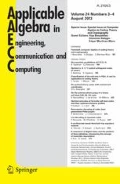Abstract
The linear complexityL 2 (G) of a finite groupG is the minimal number of additions, subtractions and multiplications by complex constants of absolute value ≦2 sufficient to evaluate a suitable Fourier transform of ℂG. Combining and modifying several classical FFT-algorithms, we show thatL 2(G)≦8|G|log2|G| for any finite metabelian groupG.
Similar content being viewed by others
References
Atkinson, M. D.: The complexity of group algebra computations. Theor. Comp. Sci.5, 205–209 (1977)
Baum, U., Clausen, M.: Some lower and upper complexity bounds for generalized Fourier transforms and their inverses. SIAM J. Comput. (to appear)
Beth, T.: Verfahren der schnellen Fourier-Transformation. Stuffgart: Teubner 1984
Beth, T.: On the computational complexity of the general discrete Fourier transform. Theor. Comp. Sci.51, 331–339 (1987)
Bluestein, L. I.: A linear filtering approach to the computation of the discrete Fourier transform. IEEE Trans.AU-18, 451–455 (1970)
Büchi, W.: Die diskrete Fourier transformation. Diplomarbeit, Universität Zürich, 1979
Clausen, M.: Fast Fourier Transforms for Metabelian Groups. SIAM J. Comput.18, 584–593 (1989)
Clausen, M.: Fast generalized Fourier transforms. Theor. Comp. Sci.67, 55–63 (1989)
Cooley, J. W., Tukey, J. W.: An algorithm for the machine calculation of complex Fourier series. Math. Comp.19, 297–301 (1965)
Diaconis, P.: Spectral analysis for ranked data. Ann. Statistics (to appear)
Diaconis, P., Rockmore, D.: Efficient computation of the Fourier transform on finite groups. Technical Report, Stanford University, April 1988
Elliott, D. F., Rao, K. R.: Fast transforms. New York: Academic Press 1982
Huppert, B.: Endliche Gruppen I. Berlin, Heidelberg, New York: Springer 1967
Hurst, S. L., Miller, D. M., Muzio, J. C.: Spectral techniques in digital logic. New York: Academic Press 1985
Karpovsky, M. G.: Fast Fourier transforms on finite non-abelian groups. IEEE Trans. Comput.26/10, 1028–1030 (1977)
Karpovsky, M. G. (ed.): Spectral techniques and fault detection. New York: Academic Press 1985
Nussbaumer, H. J.: Fast Fourier transform and convolution algorithms. Berlin, Heidelberg, New York: Springer 1981
Rader, C. M.: Discrete Fourier transform when the number of data points is prime. Proc. IEEE56, 1107–1108 (1968)
Rockmore, D.: Fast Fourier analysis for abelian group extensions. Adv. Appl. Math.11, 164–204 (1990)
Rockmore, D.: Computation of Fourier transforms on the symmetric group. In: Kaltofen, E., Watt, S. M. (eds.) Computers in Mathematics. Berlin, Heidelberg, New York: Springer 1989
Winograd, S.: On computing the discrete Fourier transform. Proc. Nat. Acad. Sci. USA73, 1005–1006 (1976)
Winograd, S.: Arithmetic complexity of computations. SIAM, 1980
Author information
Authors and Affiliations
Rights and permissions
About this article
Cite this article
Baum, U., Clausen, M. & Tietz, B. Improved upper complexity bounds for the discrete fourier transform. AAECC 2, 35–43 (1991). https://doi.org/10.1007/BF01810853
Received:
Issue Date:
DOI: https://doi.org/10.1007/BF01810853



